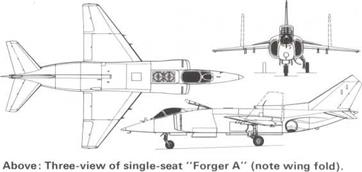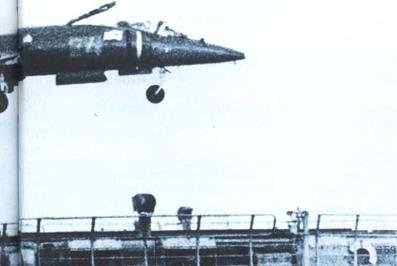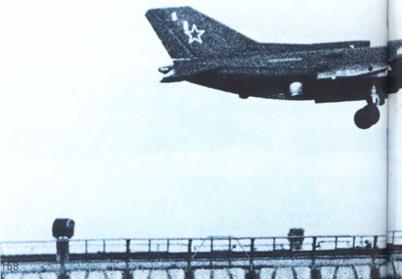Yakovlev Yak-36
Yak-36 "Forger A" and -36U ( ?)
"Forger B"
Origin: The design bureau of Aleksander S. Yakovlev, Soviet Union.
Type: Single-seat VTOL naval attack (and possibly reconnaissance) aircraft: ("Forger B") two-seat dual trainer.
Engines: One lift/cruise turbojet or turbofan of unknown type with estimated maximum thrust of 17,0001b (7710kg); two lift jets of unknown type t with estimated thrust of.5,600lb (2540kg) each.
Dimensions (estimated): Span 25ft (7-6m): length (A) 49ft 3in (15 0m),
(B) 58ft (17•7m); height 1 3ft 3in (4 0m): width with wings folded 14ft 10in (4-51 m).
Weights (estimated): Empty 12,0001b (5450kg) (B slightly heavier): maximum loaded 22,0501b (10,000kg). r
Performance (estimated): Maximum speed at sea level 722mph (1160 km/h, Mach 0-95): maximum level speed at optimum height 860mph (1380km/h, Mach T3): service ceiling about 50,000ft (15,250m): radius on hi-lo-hi attack mission without external fuel, not greater than 200 miles (320km).
Armament: Contrary to early reports there appears to be no internal gun: four pylons under the non-folding wing centre section carry gun pods, reconnaissance pods, ECM payloads, bombs, missiles (said to include AA-2 "Atoll" AAM and AS-7 "Kerry" ASM) and tanks. Maximum external load, about 4,000lb (1814kg). (B two-seater) none seen.
History: First flight probably about 1971: service delivery possibly 1975.
User: Soviet Union (AV-MF).
Development: At the 1967 show at Domodedovo a single V/STOL jet-lift research aircraft gave a convincing display of hovering and transitions.
Called "Freehand" by NATO, it was at first thought to be the Yak-36, but this is now believed to be the service designation of the combat aircraft carried above Kiev, the first of the large Soviet carriers (officially classed as anti-submarine cruisers) which also carry ASW helicopters and an unprecedented array of shipboard weapons. The "Freehand", of which fewer than ten are thought to have been built, conducted trials from a specially built platform on the carrier Moskva’ It provided information to assist the
|
|
 |
design of the Yak-36, which probably has the same large lift turbofan engine plus aft-angled lift jets behind the cockpit. To take off, the three engines must be used together and a vertical ascent made, the main nozzles being rotated to about 100° to balance the rearward thrust of the lift jets. STOL takeoffs are not thought to be possible, neither is Viffing (vectoring in forward flight) to increase combat manoeuvrability. The design is simple, though one wonders why the wing was mounted in the mid-position instead of the much’lighter solution of putting it above the main engine. The latter has plain inlets with a row of auxiliary doors as on the Harrier, but supersonic speed at height is judged possible in the clean condition. Other features include Fowler flaps, large ailerons on the folding outer wings, wingtip and tail control nozzles, a ram inlet duct in the dorsal spine, rear airbrakes, a large vertical tail with dielectric tip, and a dielectric nosecap probably covering a small ranging radar. The "Forger" В has a completely different tandem-seat nose angled downwards and a lengthened rear fuselage to preserve directional stability. The development squadron aboard Kiev on her shakedown cruise from the Nikolayev yard to Murmansk flew intensively, and observers especially noted the repeated precision of take-offs and landings, indicating ship guidance. Even this aircraft is almost certainly an interim type..

Below: ‘Forger-A’ photographed operating from Kiev in 1976; some examples of this basic single-seat version lack the row of auxiliary inlet doors between the inlet and painted flag.











